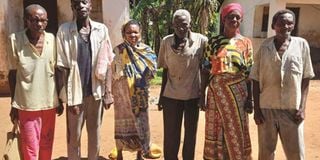Secluded for life in leprosy colonies

What you need to know:
- The mention of leprosy, just as in the Bible where the society believed the illness was a punishment for sin, still instils angst among villagers who treat lepers with derision.
- Survivors of leprosy with visibly deformed body parts, especially fingers and toe nails, left their homes to find a new community of people who can be comfortable to have them around.
As they narrate what they go through, their faces are filled with the kind of obnoxiousness that rouses moral indignation.
During meal hours, no one seems to extend a shred of tenderness towards their condition. They are given food not by hand but by the leg, just as though they were outcasts.
“We are not dogs but people treat us as such,” Ms Mlongo Chimera, a leprosy survivor told Healthy Nation when we visited Tumbe village, Msambweni, Kwale County.
Even after healing, villagers have treated them with the same contempt as before. Stigma. Trauma. No one, save for their relatives, wants to be associated with them. However, they are just dispirited but not defeated because being alive is a gift they are grateful for.
A first glance at their stone-walled block house with two doors each for a house appears decent from the outside. Here, a well-wisher built a section of leprosy survivors’ houses.

Some survivors ,however, remained in the first colony, a few metres from the second one that was built by the well-wisher. By night, their solace is 'at least we have a roof on our head', but, by day, they go out to seek help from passers-by.
In this hamlet, there are several survivors of leprosy with visibly deformed body parts, especially fingers and toe nails, who left their homes to find a new community of people who can be comfortable to have them around.
Ms Chimera is one of them. She tells us that she contracted the disease when she was a little girl still living with her parents.
“First, it was the unusual patches on my body. I also had boils on my skin that tormented me every night. We tried all kinds of traditional medicine but it didn’t work. My father brought me here to get treatment as this was the only known place,” Ms Chimera says.
Days after receiving treatment, she went back home in Duruma with her father but the disease exploded a second time. She travelled back to Msambweni for another round of treatment and never looked back.
“Duruma is an unpleasant place. They discriminate against us. My brothers and children love me, but the neighbours do not want to see me. Should there be a celebration, fingers will be pointed at you and no one would even want to have their food near you,” she vents.
“They still think that we have leprosy and even believe we can infect them,” she adds.
For Salim Ali Pato, who first set foot at the leprosy colony in Msambweni in 1966, the disease has equally not been kind to him.

“When I came here, Tumbe was the only known area for leprosy treatment. These days, there is no hospital here but the medical training centre has seen most of us get treated,” he says.
He is the representative of people living with leprosy and, unlike Ms Chimera who lives in stone-walled houses donated by a well-wisher, he stays in the original colony that has since been left in shambles.
It was originally called Tumbe but was later christened Blessed Camp. Located inside the Msambweni Kenya Medical Training Centre, the sidelined village had countable people when we visited.
The sun is right above our heads, and we are all dripping with sweat. We find Mr Nyamau Chari, another leprosy survivor, sleeping on a sisal mat under a tree. He lifts his head and struggles to stand on his feet. He tells us that he feels pain around the heart and points at his lower abdomen that is also painful.
“I was born in Kinango. I came here because of leprosy and have never gone back home. You are here today on an unfortunate day when I am not feeling well. You could not find me. I usually go out to the streets of Ukunda to borrow money because that is how I get my food. I can’t do that now because I am sick,” he tells Healthy Nation.
“We are surviving here because of well-wishers. We don’t own these houses. Should there be an eviction, where shall we go? Home is not an option because some of us left there when we were very young and were ostracised by villagers.”
Ms Christina Mwikali lives in the leprosy colony, where she takes care of her sick mother. “My original home is in Kangundo, Machakos County. My mum has patches on her skin and some of her fingers have dropped off.”
For Ms Nzambe Ndoro, she got the disease when she was still young. Just like Ms Chimera, she started her treatment with traditional medicine that did not work. “My neighbours back at home alienated me saying I would ‘destroy’ their children.”
While the colony we visited has recovered patients, the mention of leprosy, just as in the Bible where the society believed the illness was a punishment for sin, still instils angst among villagers who treat lepers with derision.
In 1998, the World Health Organization eliminated leprosy as a public health problem because the cases had declined.
Its scientific name is Hansen's disease, a name adopted from Mycobacterium leprae, a slow growing bacterium that causes leprosy.
Dr Samuel Kimaru, a doctor in Msambweni who attends to lepers, says there are some active cases. “We still treat people with leprosy but the cases are very rare.”
Dr Obura Michael, chief clinician in Busia County who has been treating people living with leprosy, says while the disease can be treated, the scars live long.
He tells Healthy Nation that the evolution of leprosy has come a long way and with new generational drugs, people can be better even in six months. “Kenya has eradicated leprosy, which means that it is no longer a public health problem, but there are still some pockets of cases that can be traced,” he explains.
In the country, he adds, leprosy mostly occurs in lowland areas like the Coast, South Nyanza and some parts of western Kenya. It is rare to find people living in highland areas with leprosy.
“A possible link to lowland areas could be its humid nature, which gives room for the bacteria to survive,” he says.
The top seven high burden counties are Kwale, Kilifi, Homa Bay, Siaya , Busia, Kisumu and Mombasa.
Medicine and the coming up of new drugs has been a major boost in the fight against leprosy. The WHO says that it is a curable disease which uses Multidrug therapy.
Dr Obura expounds that the greatest undoing for leprosy is that it affects the nerves and even when people get better after receiving treatment, some of the deformities linger on.
This report is produced in partnership with the African Investigative Journalism Conference, an initiative of the Journalism Department at the University of Witwatersrand in South Africa, and the Nation Media Group.






